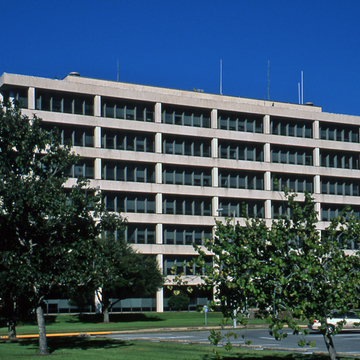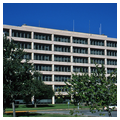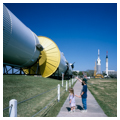You are here
Lyndon B. Johnson Space Center (NASA Manned Spacecraft Center)
Although the science and politics of rocketing Americans to the moon overshadowed the politics of Houston real estate development, the latter were strikingly evident in the freewheeling way that Texan power elites exploited their growing influence nationally to secure NASA's Manned Spacecraft Center for Houston. The naming of the complex for President Lyndon B. Johnson in 1973 identifies one of the key personalities responsible for NASA's being here (not named but also of critical importance was Houston's congressman Albert Thomas) . What names do not reveal is the high-stakes real estate game through which the Humble Oil and Refining Company (now ExxonMobil) donated two-thirds of the center's sixteen-hundred-acre site to NASA (using Rice University as their nonprofit conduit) in order to set the stage for development of the adjacent new town of Clear Lake City. Humble formed the Friends-wood Development Corporation, which initially collaborated with the Del E. Webb Corporation of Phoenix, to develop Clear Lake City, a fifteen-thousand-acre new town on what had been in the 1930s the ranch of Houston lumberman James M. West. The dominant presence of Brown and Root, a Houston-based engineering and industrial construction corporation, in the design of many of the original Manned Spacecraft Center buildings attests to the web of business and political connections in which NASA was enmeshed. Brown and Root's founders, brothers Herman and George R. Brown, were among Lyndon Johnson's foremost supporters. George Brown was also chairman of the board of trustees of Rice University.
The Manned Spacecraft Center site is a flat plane of turf and parking lots. Its buildings are a cluster of light-toned pavilions loosely aligned around a central mall behind the nine-story Project Management Building, the complex's tallest building. Visually isolated from NASA Parkway and Clear Lake City behind a chain link security fence, NASA's site appears less like a park than an office complex that failed to develop according to expectation. Its architecture reflects the participation of Los Angeles architect Charles Luckman as design consultant.
The Project Management Building was designed by Brown and Root's in-house architect Albert E. Sheppard, who was responsible for eight of the ten buildings surrounding the central mall. The pastoral landscape was designed by Houston landscape architects Caldwell and Caldwell and Robert F. White and Associates.
In 1985 two of the Manned Spacecraft Center's buildings were designated National Historic Landmarks: the Mission Control Center of 1964 by Kaiser Engineers and the Space Environment Simulation Laboratory of 1965 by the Chicago Bridge and Iron Company. The Mission Control Center, which faces the central mall, is where all U.S. space flights since 1964 have been monitored and directed. Its interior was painstakingly reconstructed for Ron Howard's film Apollo 13 (1995). In 2003, the Saturn V Launch Vehicle, with its dramatic installation that emphasizes the vehicle's stages, was listed in the National Register of Historic Places.
Writing Credits
If SAH Archipedia has been useful to you, please consider supporting it.
SAH Archipedia tells the story of the United States through its buildings, landscapes, and cities. This freely available resource empowers the public with authoritative knowledge that deepens their understanding and appreciation of the built environment. But the Society of Architectural Historians, which created SAH Archipedia with University of Virginia Press, needs your support to maintain the high-caliber research, writing, photography, cartography, editing, design, and programming that make SAH Archipedia a trusted online resource available to all who value the history of place, heritage tourism, and learning.




